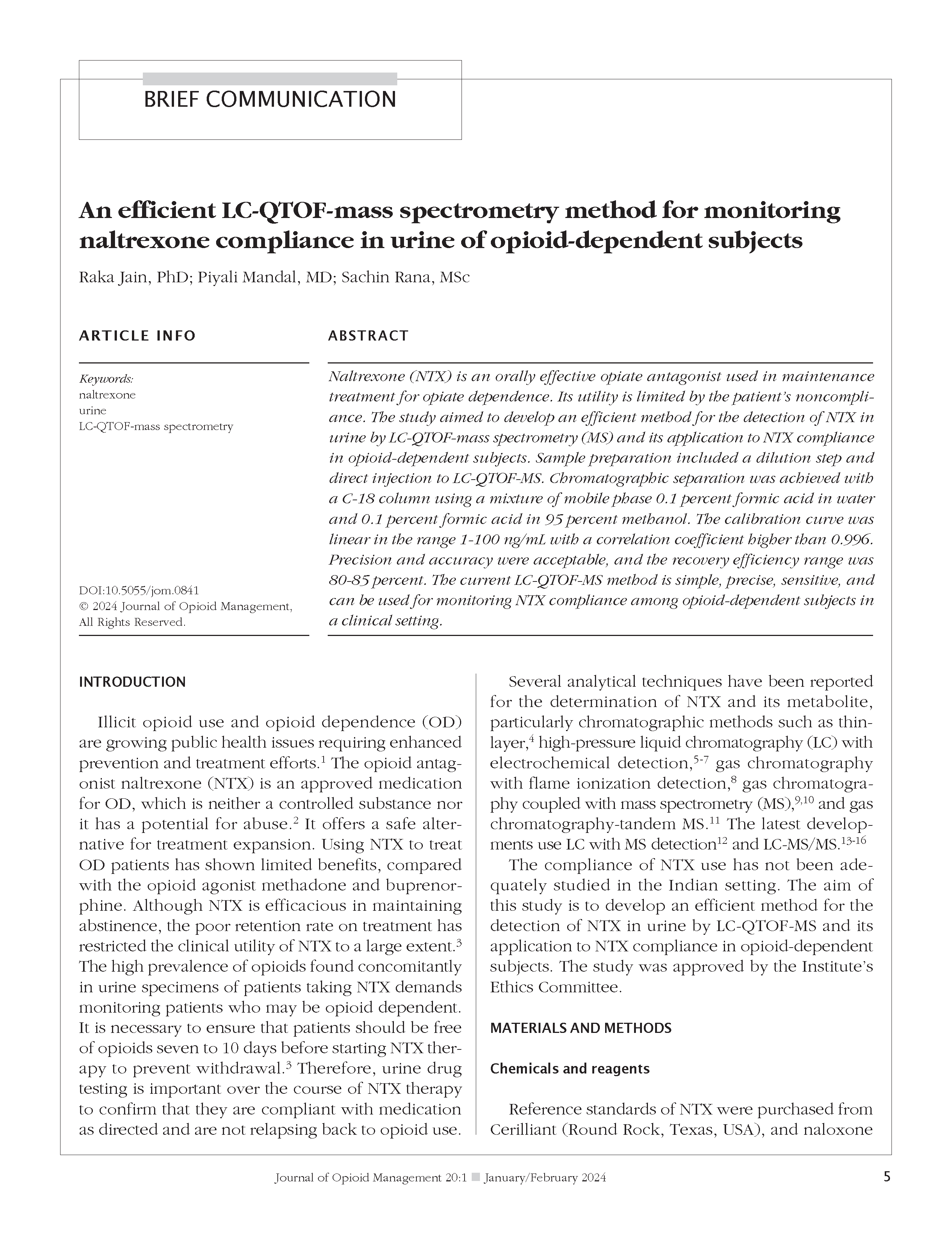An efficient LC-QTOF-mass spectrometry method for monitoring naltrexone compliance in urine of opioid-dependent subjects
DOI:
https://doi.org/10.5055/jom.0841Keywords:
naltrexone, urine, LC-QTOF-mass spectrometryAbstract
Naltrexone (NTX) is an orally effective opiate antagonist used in maintenance treatment for opiate dependence. Its utility is limited by the patient's noncompliance. The study aimed to develop an efficient method for the detection of NTX in urine by LC-QTOF-mass spectrometry (MS) and its application to NTX compliance in opioid-dependent subjects. Sample preparation included a dilution step and direct injection to LC-QTOF-MS. Chromatographic separation was achieved with a C-18 column using a mixture of mobile phase 0.1 percent formic acid in water and 0.1 percent formic acid in 95 percent methanol. The calibration curve was linear in the range 1-100 ng/mL with a correlation coefficient higher than 0.996. Precision and accuracy were acceptable, and the recovery efficiency range was 80-85 percent. The current LC-QTOF-MS method is simple, precise, sensitive, and can be used for monitoring NTX compliance among opioid-dependent subjects in a clinical setting.
References
Johnston LD, O'Malley PM, Miech RA, et al.: Monitoring the Future National Survey Results on Drug Use, 1975-2015: Overview, Key Findings on Adolescent Drug Use. Ann Arbor: Institute for Social Research, the University of Michigan, 2016: 98.
Stotts LA, Dodrill CL, Kosten TR: Opioid dependence treatment: Options in pharmacotherapy. Expert Opin Pharmacother. 2009; 10(11): 1727-1740. DOI: 10.1517/14656560903037168. DOI: https://doi.org/10.1517/14656560903037168
Nunes EV, Rothenberg JL, Sullivan MA, et al.: Behavioral therapy to augment oral naltrexone for opioid dependence: A ceiling on effectiveness? Am J Drug Alcohol Abuse. 2006; 32(6): 503-517. DOI: https://doi.org/10.1080/00952990600918973
Wall ME, Brine DR, Perez-Reyes M: Metabolism and disposition of naltrexone in man. Drug Metab Dispos. 1981; 9(4): 369-375.
Meyer MC, Straughn AB, Lo MW, et al.: Bioequivalence, dose-proportionality, and pharmacokinetics of naltrexone after oral administration. J Clin Psychiatry. 1984; 45(9 Pt 2): 15-19.
Davidson AF, Emm TA, Pieniaszek HJ: Determination of naltrexone and its major metabolite, 6-β-naltrexol, in human plasma using liquid chromatography with electrochemical detection. J Pharm Biomed Anal. 1996; 14(12): 1717-1725. DOI: 10.1016/0731-7085(96)01794-3. DOI: https://doi.org/10.1016/0731-7085(96)01794-3
Zuccaro P, Altieri I, Betto P, et al.: Determination of naltrexone and 6-β-naltrexol in plasma by high-performance liquid chromatography with coulometric detection. J Chromatogr Sci. 1991; 567(2): 485-490. DOI: 10.1016/0378-4347(91)80156-7. DOI: https://doi.org/10.1016/0378-4347(91)80156-7
Verebey K, De Pace A, Jukofsky D, et al.: Quantitative determination of 2-hydroxy-3-methoxy-6-beta-naltrexol (HMN), naltrexone, and 6-beta-naltrexol in human plasma, red blood cells, saliva and urine by gas liquid chromatography. J Anal Toxicol. 1980; 4(1): 33-37. DOI: 10.1093/jat/4.1.33. DOI: https://doi.org/10.1093/jat/4.1.33
Monti KM, Foltz RL, Chinn DM: Analysis of naltrexone and 6-β-naltrexol in plasma and urine by gas chromatography/negative ion chemical ionization mass spectrometry. J Anal Toxicol. 1991; 15(3): 136-140. DOI: 10.1093/jat/15.3.136. DOI: https://doi.org/10.1093/jat/15.3.136
Huang W, Moody DE, Foltz RL: Determination of naltrexone and 6-β-naltrexol in plasma by solid-phase extraction and gas chromatography-negative ion chemical ionization-mass spectrometry. J Anal Toxicol. 1997; 21(4): 252-257. DOI: 10.1093/jat/21.4.252. DOI: https://doi.org/10.1093/jat/21.4.252
Nelson CC, Fraser MD, Wilfahrt JK, et al.: Gas chromatography/tandem mass spectrometry measurement of Δ9-tetrahydrocannabinol, naltrexone and their active metabolites in plasma. Ther Drug Monit. 1993; 15(6): 557-562. DOI: 10.1097/00007691-199312000-00019. DOI: https://doi.org/10.1097/00007691-199312000-00019
Brünen S, Krüger R, Finger S, et al.: Determination of naltrexone and 6 beta-naltrexol in human blood: Comparison of high-performance liquid chromatography with spectrophotometric and tandem-mass-spectrometric detection. Anal Bioanal Chem. 2010; 396(3): 1249-1257. DOI: 10.1007/s00216-009-3301-z. DOI: https://doi.org/10.1007/s00216-009-3301-z
Iyer SS, Kellogg GE, Karnes HAT: A LC-electrospray tandem MS method for the analysis of naltrexone in canine plasma employing a molecular model to demonstrate the absence of internal standard deuterium isotope effects. J Chromatogr Sci. 2007; 45(10): 694-700. DOI: 10.1093/chromsci/45.10.694. DOI: https://doi.org/10.1093/chromsci/45.10.694
Slawson MH, Chen M, Moody DE, et al.: Quantitative analysis of naltrexone and 6β-naltrexol in human, rat, and rabbit plasma by liquid chromatography-electrospray ionization tandem mass spectrometry with application to the pharmacokinetics of Depotrex® in rabbits. J Anal Toxicol. 2007; 31(8): 453-461. DOI: 10.1093/jat/31.8.453. DOI: https://doi.org/10.1093/jat/31.8.453
Yun H, Bang S, Lee K, et al.: Simultaneous analysis of naltrexone and its major metabolite, 6-β-naltrexol, in human plasma using liquid chromatography-tandem mass spectrometry: Application to a parent-metabolite kinetic model in humans. Talanta. 2007; 71(4): 1553-1559. DOI: 10.1016/j.talanta.2006.07.035. DOI: https://doi.org/10.1016/j.talanta.2006.07.035
Clavijo C, Bendrick-Peart J, Zhang YL, et al.: An automated, highly sensitive LC-MS/MS assay for the quantification of the opiate antagonist naltrexone and its major metabolite 6betanaltrexol in dog and human plasma. J Chromatogr B Analyt Technol Biomed Life. 2008; 874(1-2): 33-41. DOI: 10.1016/j.jchromb.2008.08.021. DOI: https://doi.org/10.1016/j.jchromb.2008.08.021

Published
How to Cite
Issue
Section
License
Copyright 2005-2025, Weston Medical Publishing, LLC and Journal of Opioid Management. All Rights Reserved.










